Hello Fellow ChartWatchers!
There is a TON of great stuff happening at StockCharts.com right now. First off, I want to make sure that everyone is aware that our SPRING SPECIAL is going on right now. Subscribe or extend your account for 12 months and we'll give you 2 additional months for free! (Subscribe of extend by 6 months and we'll give you 1 month for free.) But please do not delay because unlike previous specials, this one will only last for ONE WEEK! That means that you have to act before May 8th or you'll miss out. Why not click here right now to take advantage of this fleeting offer? Go ahead... We'll wait.
Are you back? Good! Now for the bigger news...
CATCHING AN IMPULSE
This week marks the debut of Dr. Alexander Elder in our ChartWatchers newsletter. Dr. Elder's books are legendary - I honestly hope everyone has read at least one or two of them. They can make anyone a better investor almost instantly. I am thrilled to have him contributing to StockCharts.com now.
Dr. Elder's first contribution was to allow us to add his "Impulse System" of red, blue and green bars to our SharpCharts. Here's an example of what a chart with "Elder's Impulse System" looks like:
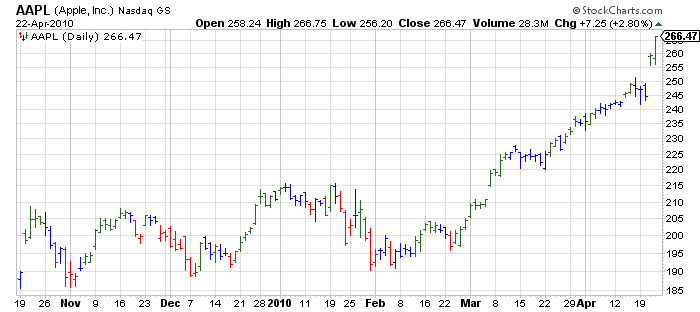
To create one of these charts, just select "Elder's Impulse System" from the "Type" dropdown on the SharpCharts page (or just click on the chart above to see an example). We've also created a new ChartSchool article that explains exactly what the colors mean and how they are arrived at.
When Dr. Elder saw his system on our site, he sent the following reaction: "It is a pleasure to see my Impulse System charts on the web for the first time!" Both he and I hope that it can help ChartWatchers everywhere.
INTRO: HOW I MANAGED MY PICK
Today Dr. Elder is also joining us as a columnist. He and Kerry Lovvom (a trader profiled in the book "Entries and Exits") currently run a website called SpikeTrade.com - a community of experienced stock traders. Each weekend, he writes a column called "How I Managed My Pick" that is a review of a trade that he entered and exited during the previous week. The column's goal is to educate people based on lessons of real-world experience. I think all ChartWatchers can benefit from Dr. Elder's articles. The article below was written on the first weekend in April. Watch for more current offerings in future newsletters. - Chip
A RACE BETWEEN A TURTLE AND HARES - ALEX ELDER
I did not expect to choose a Gold pick this week.
I expected a difficult week ahead, with many crosscurrents. Also, Inna, my manager, was taking two days off, and I knew I would have to spend a lot of time in the office, distracted from the screen. I kept looking at attractive shorts and longs, but in the end decided to go with what I thought was a defensive pick - a gold stock, AUY, picked by Colin B. one of our traders here at SpikeTrade.com.
Here is the chart of AUY at the start of the week:
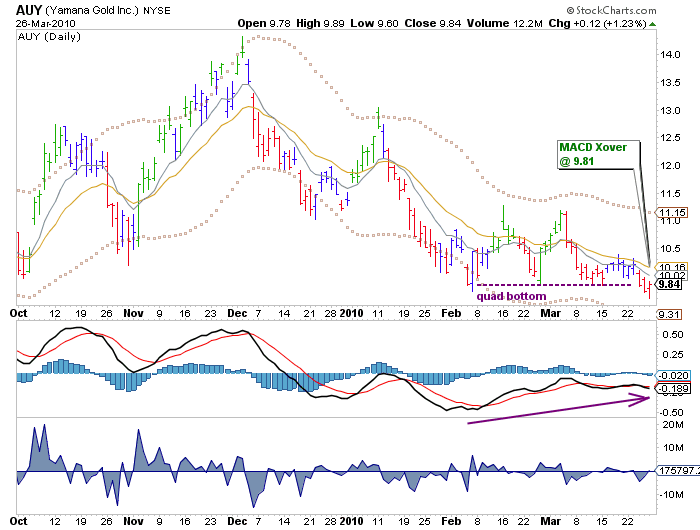
This daily chart shows a quad bottom. The three rightmost bars are Red. I love these false downside breakouts. The purple arrow indicates a potential bullish MACD divergence, and the text in the box reminds me that the Impulse system will go off Red if on Monday AUY trades at or above 9.81.
On Monday, AUY exploded on a gap, making me think I missed the boat, but on Tuesday it began to sag. As I lifted my head from Inna's work in late afternoon, I noticed that AUY had touched 9.80. I figured it would want to poke its toe a little lower and placed an order to buy at 9.79.
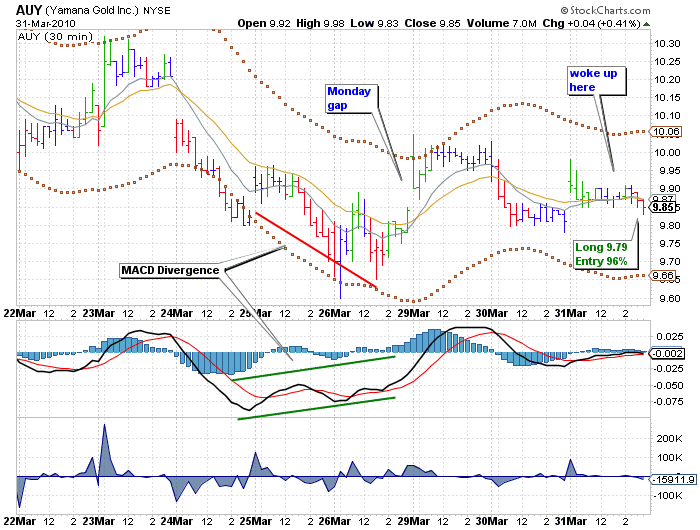
I usually do not discuss my trade sizing in these reports, but will do it now because it shows something useful about risk management. On Sunday, facing a busy week, I decided to risk only $500 on this trade. My initial plan was to enter at 9.85 with a stop at 9.61, risking 24 cents per share, allowing me to buy 2,000 shares.
I call this the Iron Triangle of risk control: you know you maximum risk, you know your risk per share, you divide A by B to get the permitted number of shares.
On Tuesday, buying at 9.79 with the same stop, my risk per share was only 18 cents. Dividing $500 total permitted risk by 18 cents allowed me to bump up the size of my trade to 3,000 shares. I placed an order with eTrade which allows me trade unlimited size for $7.99. My entry grade was 96%, meaning I just about caught the low of the day.
On Wednesday AUY rallied, then sagged, but kept above my entry level. I am a great believer in holding out for a good buy, and it paid off here.
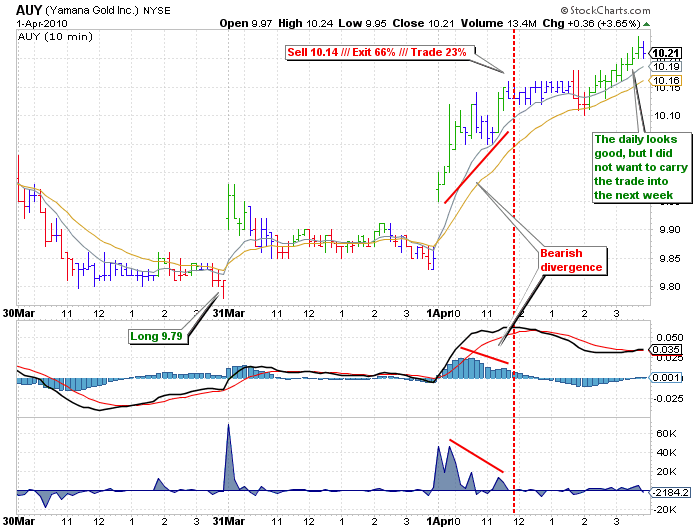
On Thursday, the last day of this short week, AUY rallied with great conviction. I seriously considered making it a longer-term trade, but caution prevailed; I prefer not to carry SpikeTrade picks like this one over the weekend. With Inna back in the office and me being able to concentrate on the screen, I was watching the intraday charts. When I saw a bearish divergence on the intraday chart, I took profits at 10.14. The gain was $1,050.
The lesson of this trade is that in a market driven by heavy crosscurrents a cautious defensive pick may well be the best solution!
All the best,
Alex
Three Thursdays ago (April 8), I wrote about the upturn in the price of
gold and gold stocks. At the time, gold was breaking through a bullish
"neckline" in a head and shoulders bottom while the Gold Miners Index
was breaking through its March high. On Tuesday, I showed the Gold ETF
(GLD) reaching a new 2010 high after a successful retest of its
neckline. Today I'm going to focus on mining stocks which are starting
to emerge as new market leaders. Chart 1 shows the Market Vectors Gold Miners ETF (GDX)
trading at the highest level since January. This week's upside breakout
has also taken place on rising volume which is another positive sign.
So is the fact that the GDX/SPX relative strength ratio (below chart)
is rising above its 2010 down trendline. That shows new leadership. The
reasons for the latest upturn in gold assets are twofold. One is simply
the fact that commodity prices have been lagging behind stocks and are
starting to play catchup. Another is that gold plays a dual role as an
alternate currency and is attracting some money coming out of Europe.
[Gold is trading at a record high against the Euro, the British Pound,
and the Swiss Franc]. The second point is illustrated by the fact that
gold rose earlier in the week (when Greek debt was downgraded to junk)
while most other commodities fell.
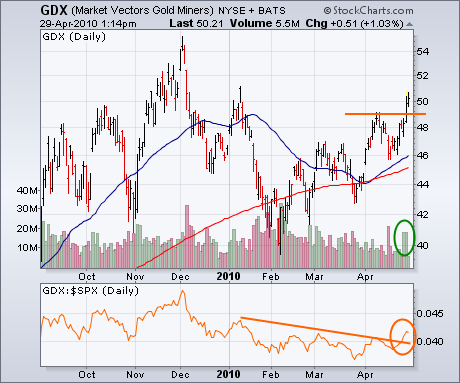
With the third long red candlestick in three weeks, the Dow Industrials is once again testing support in the 11000 area. The senior average first exceeded 11000 on April 14th and then moved into a trading range. While a support break would be short-term bearish, it would not be enough to affect the bigger uptrend. After a 1300 point advance in just 11 weeks, the Dow was overbought and ripe for a pullback or consolidation. Even the best athletes need to rest after long sprints. Should a correction unfold, we can turn to broken resistance and the Fibonacci Retracements Tool to estimate downside targets. Broken support and the 38% retracement converge around 10700 for the first target.
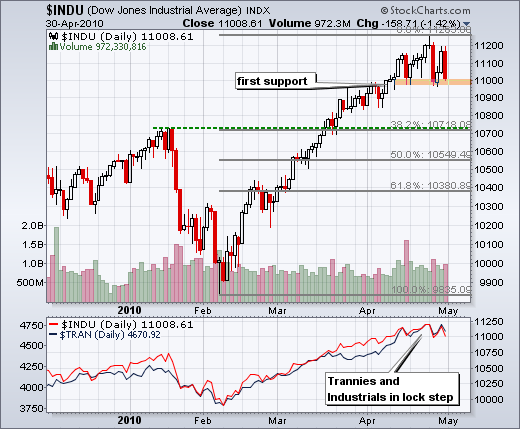
Click this chart to see the details.
SIX-MONTH SEASONALITY: Research published by Yale Hirsch in the Trader's Almanac
shows that the market year is broken into two six-month seasonality
periods. From May 1 through October 31 is seasonally unfavorable, and
the market most often finishes lower than it was at the beginning of
the period. From November 1 through April 30 is seasonally favorable,
and the market most often finishes the period higher. (See Sy Harding's
book Riding the Bear for extensive details on this subject.)
While the statistical average results for these two periods are quite
compelling, trying to ride the market in real-time in hopes of
capturing these results is not always as easy as it sounds. Below are
one-year charts that begin on May 1, and end on April 30, covering the
last four years. The left half of the chart shows the unfavorable May
through October period and the right half shows the favorable November
through April period. The green line shows the beginning of the
favorable period, the red line the beginning of the unfavorable period.
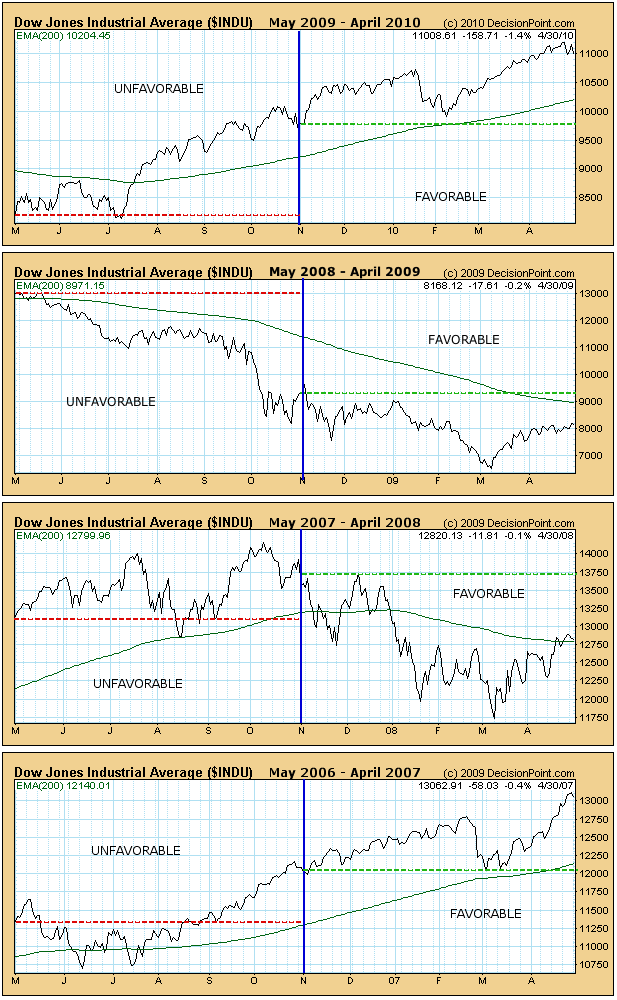
As you can see, regardless of how the market performs on average, every
year is different and presents its own challenges, and there is no
guarantee that any given period will conform to the average. In fact,
it is obvious, at least in the last few years, that bull and bear
market pressures will override seasonal tendencies more often than not.
Conclusion: Be aware of current seasonal tendencies, but first and
foremost follow the primary trend.
In my last article I suggested the financials were topping and that would make any further advance in the market difficult. Well this past week the action on the NASDAQ and Russell 2000, home of the high beta stocks, confirmed the bearish action. We've seen several warning signs develop over the last several weeks. These include extremely overbought conditions on both daily and weekly timeframes, negative divergences on the MACD on daily and weekly timeframes, outrageous relative complacency unlike anything we've seen since the CBOE began providing us equity only option data in 2003, and significant price resistance levels.
First, let's take a glance at the Russell 2000:
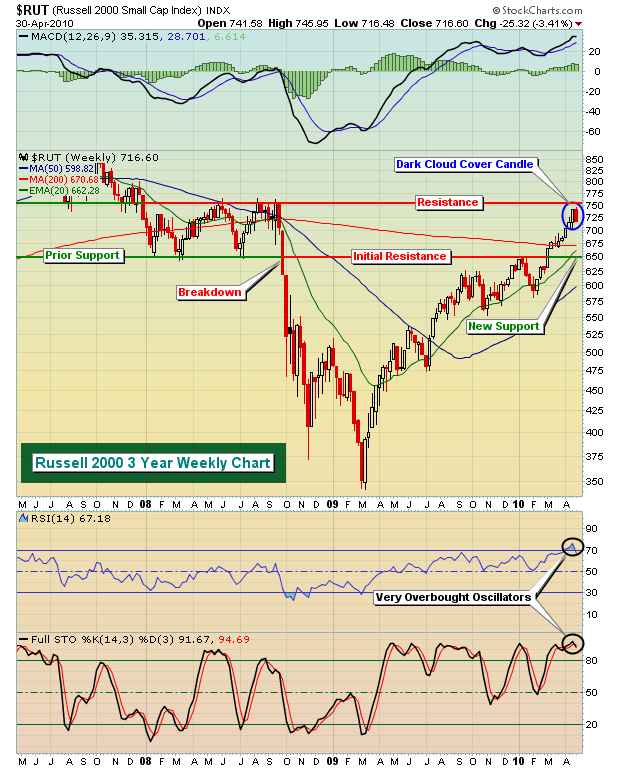
The 650-750 area appears to be the trading range for the Russell 2000 now. After weeks of steady movement higher, the bearish dark cloud cover candle from last week suggests the near-term is likely to be a bit more dicey. The 20 week EMA is at 662 and rising and that too has proven to be a solid support level over the past year. The Russell 2000 is being featured as our Chart of the Day for Monday, May 3, 2010 and can be viewed by CLICKING HERE.
The NASDAQ is a bit more bearish considering that it still has a long-term negative divergence present on its weekly chart. That has the potential of leading to a 50 week SMA test to "reset" this oscillator. Take a look:
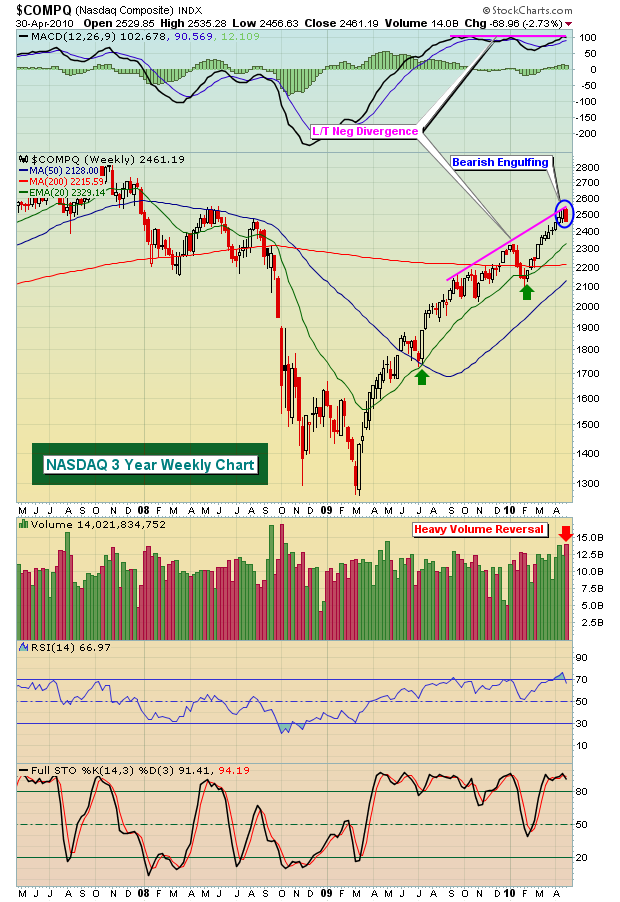
I discussed in my last article the tendency for the S&P 500 to follow the lead of financials. Given the relative weakness in that group, we must respect the likelihood that another consolidation period began this week. Having the NASDAQ, a leader during the advance off the February lows, confirm our many bearish indicators with a DAILY close beneath its 20 day EMA for the first time since February is simply more evidence that the market is likely to take the breather it very much needs and deserves. The Russell 2000, another relative leader since February, closed a fraction above its 20 day EMA on Friday and should be watched closely as a new trading week unfolds.
Until new highs emerge on our major indices, I'd view any short-term strength as an opportunity to lighten up on longs and/or hedge against further near-term weakness. I'm not bearish equities at this point as a major uptrend is still intact, just cautious given the warning signs, elevated risks and an underperforming financial group.
Happy trading!
We are rather interested in the manner Copper is trading at present, for Copper has shown itself in recent months to be a leading indicator of the path of the S&P 500. Perhaps this is due to it's economic sensitivity, or perhaps it is due to it's positive correlation with Chinese equities. In any case, the Copper/S&P 500 relationship is important to our trading regime. One cannot help but see that Copper bottomed in late December-2008 before the S&P 500 bottomed in March-2009, which we all know led to a rather material advance until January-2010. At that point, Copper topped out before the S&P 500, and then traded sharply lower - the S&P 500 followed shortly thereafter.
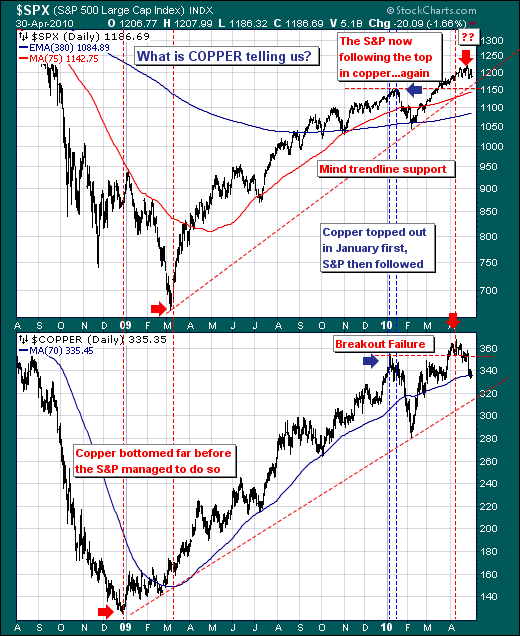
So, it should benefit readers to see that the current Copper decline is rather material, and we're now starting to see the impact of lower Copper prices upon the S&P 500 as it trades lower - with the prospect rather good of still further declines ahead. We're also interested in whether Copper breaks below its 70-day moving average, for it it does - then the S&P should experience weakness through a number of important technical levels such breaking below rising trendline support and very likely below its 75-day moving average at 1150. In the end, major bull market support at 1085, which is roughly -10% from current levels, and well within the tolerances of a "shake-out" correction before the bull market resumes.
Good luck and good trading,
Richard